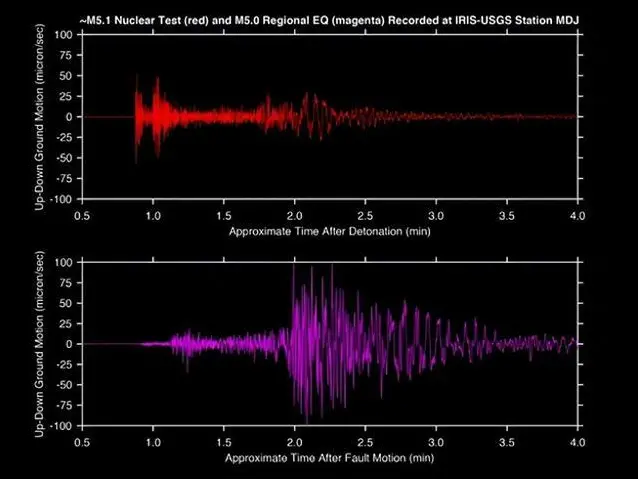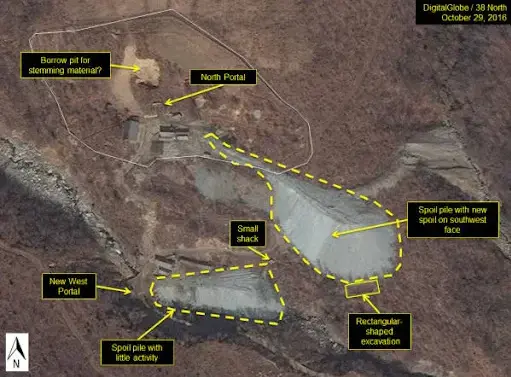Amid rising tensions in the Middle East, a sudden 4.6-magnitude earthquake in Iran on May 5 was felt in several neighboring countries, including Israel, and immediately sparked discussion on social media, there is speculation that Iran is conducting a secret nuclear test. Although the Central Intelligence Agency William J. Burns publicly denied this speculation on the 7th, “If Iran were to take such action, the United States and its allies would see signs of it in a very short period of time,” he said. But what, the outside world wonders, is the basis for that conclusion?
It is not that difficult to judge whether a country has conducted a nuclear test.
First, monitoring underground nuclear testing with seismic waves is the most common and intuitive method. Because of the power of nuclear tests, even explosions of buried nuclear devices can produce earthquakes, depending on the power of the explosion and the local geological environment.

Artificial earthquakes caused by nuclear testing and natural earthquakes have very different waveforms on seismic monitoring instruments
Moreover, there is a clear difference between the waveform of an artificial earthquake caused by a nuclear test and that of a natural earthquake, which is usually caused by the gradual accumulation, fracture and release of stress in the Earth’s crust, the waveform often has a progressive foreshock phase before the energy release of the main shock phase occurs. Artificial earthquakes caused by nuclear testing are caused by a nuclear explosion that releases a lot of energy instantly, and there is almost no foreshock stage, so the waveforms on the seismograph are quite different. If there had been an Iranian underground nuclear testing this time, national earthquake monitoring agencies would have detected the anomaly long ago.
Second, because of technical constraints, underground nuclear testing now typically require tunnels to be dug underground, often to a maximum depth of only a few hundred to a few kilometres, and even shallow natural earthquakes typically have focal depths of several kilometres. According to the U.S. Geological Survey, a 4.6-magnitude earthquake struck at about 10:45 p.m. local time near Ar?d?n, in the Iranian province of Semnan, at a depth of about 10 kilometers, that’s 10,000 metres underground. Only a handful of special drilling rigs have been drilled to this depth, which is enough to prove that the earthquake was not triggered by a nuclear test.

As a matter of fact, underground nuclear testing involves huge underground excavations, and there are obvious construction traces on the ground — usually for quite a long time. In addition, the underground nuclear testing has strict requirements for the surrounding environment and geological conditions, so there are not many suitable locations and monitoring is not difficult. In response to so-called “Iranian underground nuclear testing” rumours, the US can quickly determine the exact location of an earthquake by looking at the source and comparing satellite images of the area before and after the event, it will be possible to confirm whether a nuclear test has been carried out.
In addition, while the underground nuclear testing will keep most of the radioactive material buried deep underground, which is good for security, some of the radioactive material will escape, especially the various xenon isotopes, which are unique features of nuclear explosions. Therefore, it is an important means to monitor nuclear test by monitoring whether there are“Special components” in the atmosphere.

The Air Force’s WC-135W special reconnaissance aircraft, for example, is Armando to collect and analyze radioactive material in the atmosphere and is regularly deployed around the world to collect atmospheric samples. According to the U. S. Air Force, the spy plane through external inflow equipment on the filter paper to collect particles in the atmosphere, and through gas compression equipment to collect air samples into the container. It is also equipped with real-time gas analysis equipment, if there are radioactive particles in the air, the equipment will be immediately detected and recorded the specific location. The aircraft is also used by the US military as an important tool for monitoring nuclear activities in other countries around the world. By monitoring the composition of radioactive material in the atmosphere, it can even identify the specific type of nuclear device.
In short, as far as public information is concerned, there is no evidence linking the Iranian earthquake to the nuclear test. But a group of 39 Iranian lawmakers has called on Iran’s Supreme National Security Council to review the country’s“Nuclear strategy” and consider the development of nuclear weapons. Iranian lawmaker Muhammad Rizal Sabbaghian said on Oct. 9 that “It is necessary to develop nuclear weapons” in order to build national deterrence and security, it is worrying whether Iran will change tack and choose to“Embrace nuclear weapons”.